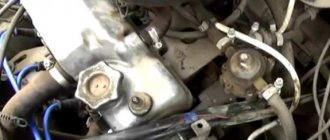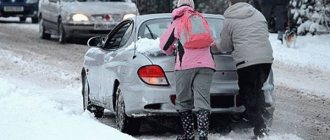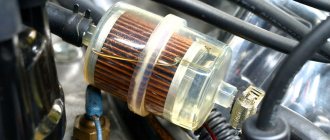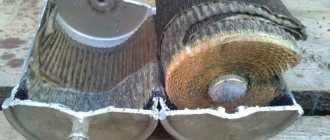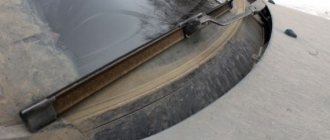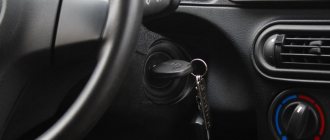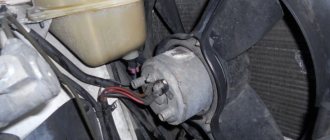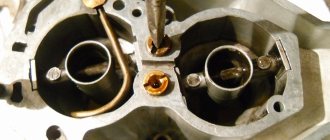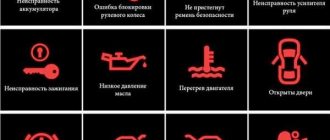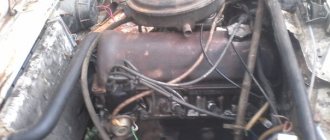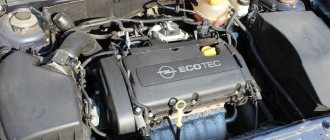Concurrent symptoms
As a rule, the situation is accompanied by a number of other signs:
- unstable operation of the internal combustion engine in idle mode;
- difficulty starting;
- loss of power and throttle response of the power unit;
- rapid overheating of the motor;
- increase in fuel consumption.
Note also that in such a situation the car accelerates poorly. When you press the accelerator pedal, jerks, dips, and delays appear. The car jerks a lot, especially in transition modes. The power plant does not so much work as “sneeze.”
Rich mixture
When the engine runs on an over-enriched fuel mixture, a coat of black soot appears on the electrodes of the spark plugs. If there is a lot of carbon deposits, then at high temperatures it can cause a portion of the mixture to ignite at the wrong time. This will also cause popping and firing as the intake valve will still be open at this time. The malfunction only manifests itself when the engine is hot. Gradually, the engine will sneeze more and more often. But the power will practically not drop - this can be observed in very rare cases.
High-voltage wiring and OZ
It is recommended to start diagnostics with the ignition system. All armored wires must be thoroughly tested, because disorganization of the placement of spark plug outlets will easily lead to chaos in the supply of sparks to the cylinders of the engine unit. It is when the high-voltage wires are mixed up and unstable operation of the internal combustion engine is observed, shooting into the carb, etc.
Why does the engine fire the carburetor?
There are special marks on the ignition distributor cover. They are intended to indicate the exact wiring diagram. This point with the spark plug outputs must be checked, and only then proceed to the settings of the OZ.
If early ignition is set, then shooting into the carburetor should definitely be present. This can be explained simply - the impulse passes too quickly, the fuel assembly is ignited not at the moment the compression process is completed, but in the phase when the piston approaches TDC.
A knocked down OZ creates a situation where the mixture burns out untimely and the combustion process is disrupted. The lumbago increases and can also radiate into the exhaust system (with late ignition). The worst thing is that the burning out of the remaining fuel assemblies spreads to fresh charging doses. This mixture enters the engine from the carb during startup, and it begins to overheat greatly.
Early ignition
You can determine the settings of the OZ that have been disrupted by the candles, or rather, by their color. A white coating on them or the appearance of soot will be a signal for the driver, who must check and set the correct ignition by adjusting the OZ. The distributor is adjusted by turning it.
The distributor itself can also become a reason to shoot into the carb. Often it deteriorates or problems arise due to a breakdown of the cover, failure of the slider or armored wiring at the points of their connection.
It is recommended to check the magnetic regulator and pay attention to the distributor bearing. During the diagnostic process, it would be correct to use an initially functional distributor and carry out diagnostics on it. This will allow you to quickly and accurately localize device problems. The same actions are carried out with the switch, because if it malfunctions, the entire spark formation process is disrupted.
What to do if the engine shoots into the carburetor and muffler
The appearance of popping noises in the muffler and carburetor is usually accompanied by a whole list of other symptoms:
- the engine “shoots” and does not start;
- work at XX is extremely unstable;
- the engine loses power and does not “pull”;
- the motor is prone to overheating;
- fuel consumption increases noticeably;
In this case, the unit’s response to pressing the gas pedal is not clear; delays and dips appear; the machine may jerk under load and in transient modes. In the language of ordinary car enthusiasts, the engine begins to “sneeze.” If the carburetor shoots when starting the engine, and the additional symptoms described above are also present, then certain elements and settings should be checked.
Diagnostics of the ignition system and OZ settings
The check should begin with the high-voltage wires of the ignition system. Violating the order of their connection will lead to the fact that the moment of spark formation on the spark plug will not occur at the end of the compression stroke, and the very order of supplying sparks to the cylinders during engine operation will also be disrupted. In this case, the engine may start, but during operation there will be shooting in the carburetor, which will be repeated at certain intervals. To solve the problem, you should connect the wires to the spark plugs, taking into account the fact that there are special marks on the distributor cover. These labels will help you make connections in the correct order.
Lean fuel assembly
Operating a carburetor on a lean fuel assembly often becomes a source of popping noise a priori. This is due to the combustion process itself, which in this case occurs slowly. Symptoms of this type of malfunction are similar to ignition failures. The poor fuel assembly burns after a new intake stroke begins.
Lean fuel mixture
A lean fuel assembly is almost the main reason for overheating of the power plant. The pop is created first in the intake, and only then the sound is transmitted to the mixing chamber of the carb.
The root causes of the formation of a lean fuel assembly must be sought in the carburetor itself, fuel lines, filters or in the fuel pump. As a rule, this is due to air penetration into the system or clogging of the jets, which are the main components - dispensers.
It is also important to be able to check at what level the fuel is in the float chamber. Often something similar happens due to the curvature of the float.
At the same time, it would be a good idea to test the accelerator pump. This part of the carburetor can also play a role when shots appear. This is especially true if it shoots when you press the gas pedal.
Carburetor accelerator pump
If the problem is related to the carburetor and its components, then sometimes it is enough to treat the inside of the device with an aerosol spray to clean the metering devices. After that, all that remains is to properly adjust everything. It would also be a good idea to replace the fuel filters.
Switch failure
Typically, a breakdown of the switch makes it impossible to start the engine, so popping noises will be observed when trying to start. To diagnose, just install a new device. If the motor stops firing, then the switch needs to be replaced or repaired. What to do depends on the type of breakdown and the capabilities of the car owner.
Very often this malfunction can be detected at an early stage. The engine speed begins to fluctuate, and when you sharply press the gas pedal, the car accelerates with dips in traction. Small popping noises are heard from the engine compartment.
timing belt
Shots in the carburetor often appear after repairs at a service station. A crookedly installed mechanism belt is the reason for this. Needless to say, this negatively affects the entire gas distribution process. A phase failure occurs and the fuel assembly burns out untimely.
Timing belt
The problem is “treated” by correctly aligning the belt to the marks. If the rubber has lost its original properties, then it is advisable to replace such a part with a new one.
The reasons for shooting into the carburetor and troubleshooting are clearly visible in the table.
| Cause of malfunction | What's happening | What to do |
| High voltage wires are connected in the wrong order | The spark will not jump on the compression stroke as expected, but on other strokes, since the sequence of operation of the engine cylinders will not be observed. Moreover, the internal combustion engine can even start and run for a while, periodically shooting into the carburetor. | In such a situation, you should reinstall the wires from the spark plugs into the distributor cover starting from the installation mark on it counterclockwise in the order: 1-3-4-2. |
| Ignition too late | Late ignition, when the spark jumps too late during the compression stroke and combustion of the working mixture occurs throughout the entire subsequent power stroke, and not just during compression. At the moment when the intake valves begin to open, the old fuel mixture still burns out and ignites a new portion of the fuel assembly coming from the intake manifold and carburetor on the intake stroke. There is a pop in the carburetor. A side effect is engine overheating and white spark plugs. | Set the correct ignition timing |
| The distributor is faulty | A “broken” cover, slider, high-voltage wires, or faulty Hall sensor can lead to improper engine operation in different modes. It is also possible that the bearing holder is loose or the ignition distributor bearing itself is worn out. | In such a situation, to quickly diagnose a malfunction, the easiest way is to temporarily replace the distributor with a known good one. |
| The ignition system switch is faulty | Correct and timely sparking in the ignition system is disrupted. | Replace the switch with a known good one. |
| The timing belt jumped 1-2 teeth | This situation is possible after repairing the engine, replacing the timing belt, or when the timing belt is loose or worn. Again, combustion of the fuel mixture occurs when the intake valves are open, which is accompanied by a “shot” into the carburetor. | The timing belt needs to be reinstalled. |
| Lean fuel mixture | If a lean fuel mixture enters the engine, flashes (popping and sneezing) in the carburetor are possible. The reason for this is the slow combustion of the lean mixture. While the intake stroke begins in the cylinder after the exhaust stroke (the intake valve opens), the combustion of the fuel mixture continues in the combustion chamber. The incoming fresh combustible mixture ignites, and combustion spreads through the intake manifold in the form of a flash, causing popping noises in the carburetor mixing chamber. | In such a situation, you should check the fuel level in the float chamber, the cleanliness of the air and fuel jets. |
General manifestation of the malfunction
Popping noises in the carburetor may appear under the following circumstances:
- after engine repair;
- there was an accident or a pothole on the road;
- tuning or simply adjustment of the carburetor was carried out;
- the car has high mileage.
In this case, a malfunction may occur in the following cases:
- when you press hard on the gas pedal;
- after parking, with a cold engine;
- on the go under load;
- when trying to start the engine.
Depending on the reason that caused the carburetor to shoot, popping noises can appear either abruptly or gradually, increasing in intensity daily. Operating a car when the engine sneezes into the carburetor, in addition to discomfort for the driver, can lead to the need for major engine repairs.
Featured Posts
Hurik
- Newbie
- Users
- 1
- 19 publications
- Car make: VAZ21063
- From:Donetsk
Hello. I have a VAZ21063 with a contact ignition Solex carburetor, the car started shooting at the carburetor when the 2-chamber was opened. I myself understand the ignition and the carburetor. I washed, blew out the carburetor, rebuilt the trampler, adjusted the valves, set the ignition, checked the compression to 10 in all, changed the spark plugs and wires, none of the above helped. Help who can.
Susanin33
- local
- VIP Member
- 66
- 1,503 publications
- Car make: VAZ – 21093
- From: Russia, Vladimir
Help who can.
lean mixture, early ignition, insufficient closing of the intake valve
Protva
- Mechanic
- VIP Member
- 356
- 6,001 publications
- Car make:Chevrolet Lanos SX
- From: south Mos. region
I'll add a blown gasket between the manifold and the head.
zhigalo
- Advanced
- Advanced Members
- 3
- 263 publications
- Car make: VAZ 2107
- From:Kostanay
Did you set the distributor according to the marks?
Hurik
- Newbie
- Users
- 1
- 19 publications
- Car make: VAZ21063
- From:Donetsk
lean mixture, early ignition, insufficient closing of the intake valve
I changed the 2-carb plus adjusted it, set the ignition earlier and later, checked the valves twice, measured the compression at 10 in all. Nothing has changed.
Hurik
- Newbie
- Users
- 1
- 19 publications
- Car make: VAZ21063
- From:Donetsk
I'll add a blown gasket between the manifold and the head.
the engine runs fine at XX, the tasol does not go away, the spark plugs c1-4 are red, the engine does not run louder. The car began to shoot at the carburetor when opening the 2nd chamber. What is the problem with the gasket between the manifold and the head????
Hurik
- Newbie
- Users
- 1
- 19 publications
- Car make: VAZ21063
- From:Donetsk
Did you set the distributor according to the marks?
Yes, according to the marks.
Susanin33
- local
- VIP Member
- 66
- 1,503 publications
- Car make: VAZ – 21093
- From: Russia, Vladimir
Yes, according to the marks.
vacuum advancer
Hurik
- Newbie
- Users
- 1
- 19 publications
- Car make: VAZ21063
- From:Donetsk
vacuum advancer
The vacuum corrector was checked to be normal, I even tried turning it off, no change.
Protva
- Mechanic
- VIP Member
- 356
- 6,001 publications
- Car make:Chevrolet Lanos SX
- From: south Mos. region
spark plugs s1-4 red
It is better to replace spark plugs with red insulator. Over time, they begin to break through to ground.
Sorrel
- Advanced
- Advanced Members
- 29
- 365 publications
- Car make: VAZ 21093
- From:Russia
I’ll get into the conversation, try to pull out the choke a little, and you’ll go for a ride. It’s quite possible that he’ll stop shooting, if he stops I’ll tell you what’s going on next))) If he continues to shoot, I won’t be able to do anything to help. And even if the car is warmed up, still open the choke a little while driving.
Hurik
- Newbie
- Users
- 1
- 19 publications
- Car make: VAZ21063
- From:Donetsk
I’ll get into the conversation, try to pull out the choke a little, and you’ll go for a ride. It’s quite possible that he’ll stop shooting, if he stops I’ll tell you what’s going on next))) If he continues to shoot, I won’t be able to do anything to help. And even if the car is warmed up, still open the choke a little while driving.
The choke really helps and the engine stops firing! what’s the matter??? share your guesses, is it really possible that the carb is fucking brains....?
Protva
- Mechanic
- VIP Member
- 356
- 6,001 publications
- Car make:Chevrolet Lanos SX
- From: south Mos. region
It's also interesting to know what the reason is. I can only assume that somewhere... I won’t guess. Waiting for Sorrel
.
Hurik
- Newbie
- Users
- 1
- 19 publications
- Car make: VAZ21063
- From:Donetsk
It is better to replace spark plugs with red insulator. Over time, they begin to break through to ground.
The spark plugs have nothing to do with it, I changed the same canoe.
Sorrel
- Advanced
- Advanced Members
- 29
- 365 publications
- Car make: VAZ 21093
- From:Russia
Do you have a temperature regulator? Today I personally encountered popping noises (in Moscow today it was -12), all this was due to the supply of Cold air, (I didn’t have a thermostat on the 9th) I installed it, the popping noises disappeared. So the problem with popping noises is that Pts gets into the carburetor. cold air. check the thermostat, maybe it hasn’t been working for a long time...
VAZochnik
- Newbie
- Users
- 0
- 9 publications
- Car make:VAZ 21061,VAZ 21074,VAZ 21124,
- From: Mordovia
If five carburetors have already been changed and there are no changes, then the problem is not with them (c).
In my opinion, you need to completely change the SZ distributor + coil. Take known good ones and see what changes. Start by replacing the coil; if that doesn’t help, change the distributor assembly.
I had a similar problem - that in the end it hurt - no one could explain. Some shouted that the capacitor on the distributor was broken, others that its bearing was jammed... It ended with the transition to BSZ. The troubles are over.
Motorist
- Advanced
- Advanced Members
- 17
- 375 publications
- Car make: VAZ 21074, Java 638.
- From: g. Pavlovo
In the winter, with the air cap turned off, my air pump would stall for the winter. You drive and drive, and suddenly the engine stalls. You wait for 10 minutes and you can go again. I turned the lid to winter time and that was it. And SZ has nothing to do with it. This is the same as trying to eliminate rear axle noise by changing the pump bearing.
n1ger
- Guru
- VIP Member
- 28
- 562 publications
- Car make:VAZik 21043
- From: Saldyukino
Idk... I drove around all winter with the switch turned off =)
and now the pan has been sawn apart =) it doesn’t seem to stall or fire...
although... there is... it happens... the scolex began to shoot (rarely, really, very rarely). I didn't notice this with ozone.
Hurik
- Newbie
- Users
- 1
- 19 publications
- Car make: VAZ21063
- From:Donetsk
Idk... I've been driving around all winter with the switch not turned =)
but now the pan has been sawn apart =) it doesn't seem to stall or fire...although... there is... it happens... the scolex began to shoot (rarely, really, very rarely). I didn't notice this with ozone.
What kind of Solex, and what kind of jets are they?
n1ger
- Guru
- VIP Member
- 28
- 562 publications
- Car make:VAZik 21043
- From: Saldyukino
Solex 83-51... rebuilt =D
top from 83 regular, bottom from 83-51. I bored out the diffusers to 2324. I don't remember the jets.
seems like this:
TZh1 107.5 VZh1 150
TZh2 115 VZh2 165
(I can’t find a standard repair kit for 21053-20 =((( )
I installed the current accelerator nose from the Niva and that’s it.
Hurik
- Newbie
- Users
- 1
- 19 publications
- Car make: VAZ21063
- From:Donetsk
Guys, does anyone have a Solex08 without modifications on the 11th engine, and with what jets? Otherwise I’m stuck... surf the forums, one has some tariffs for jets, another has different ones, huh.. you’ll understand which ones are needed. I have
GTZH 1.K-97.5 GTZH 2.K-97.5 GVZH 1.K165 GVZH 2.K125
Hurik
- Newbie
- Users
- 1
- 19 publications
- Car make: VAZ21063
- From:Donetsk
AU...... Is it really possible that 518 people who read the topic cannot answer the last question asked!!!!!!!!!!!
Radio technician
- Master
- VIP Member
- 578
- 2,185 publications
- Car make: VAZ 21053
- From:Ekaterinburg
What does carb have to do with it? The chain is ground off faster and the phases are delayed. This includes closing the intake valve during early ignition. They put it on early because the engine doesn't work (?).
Hurik
- Newbie
- Users
- 1
- 19 publications
- Car make: VAZ21063
- From:Donetsk
What does carb have to do with it? The chain is ground off faster and the phases are delayed. This includes closing the intake valve during early ignition. They put it on early because the engine doesn't work (?).
My friend, you didn’t understand me, the problem with shooting into the carb was solved by increasing the valve clearance. Now the problem is the following, I recently installed a Solex 08 since my native ozone has worn out in 21 years, the jets on the Solex are as follows
GTZh 1.K-97.5 GTZh 2.K-97.5 GVZh 1.K165 GVZh 2.K125, at xx the engine is like a clock, on the 1st chamber it runs great, but on the 2nd chamber the car becomes stupid, jerks and there is no acceleration. Carb soap was blowing through the effect 0. What's the matter? Maybe the level in the PC or the jets is not what it should be?
ivan65
- Newbie
- Users
- 0
- 4 publications
- Car make: VAZ 2107
- From: Rostov
It is necessary to adjust the fuel pump pusher (either it sticks out a little or is worn out, if it is worn out, replace it with a new one) and this will most likely help. As a rule, the malfunction is on the surface - you just need to think about it.
Carburetor not tuned
Often the reason that the engine shoots into the muffler is an incorrectly configured carburetor. Its task is to create a fuel-air mixture, which is then supplied to the engine. If it is configured in such a way that the mixture is oversaturated with gasoline, a situation similar to that described above is created. The solution here is to check and adjust the “carb”.
The first step is to check the fuel level in the chamber where the float is located. Each carburetor is individually adjusted and has its own level. However, if its cover is removed, the float should be flush with the level of the cover. If this is not the case, adjust the level. Also be sure to check the integrity of the float . If it is damaged, fuel may leak into it, causing it to display the level incorrectly.
The reason that the carburetor shoots into the muffler may also be the jets. They are either configured incorrectly or become clogged over time. If the air jet does not supply enough air, the mixture becomes oversaturated with gasoline with the result described above. Often this malfunction occurs when the engine goes from idle to higher speeds, or with a sharp increase in speed (acceleration). It is necessary to check the condition of the jets and clean them if necessary.
| Air/fuel ratio | Description | A comment |
| 6/1 — 7/1 | Extremely rich mixture. Ignition failure. | Rich mixture. Long burning, low temperature. |
| 7/1 — 12/1 | Overrich mixture. | |
| 12/1 — 13/1 | Rich mixture. Maximum power. | |
| 13/1 — 14,7/1 | Slightly enriched mixture. | Normal mixture. |
| 14,7/1 | Chemically ideal ratio. | |
| 14,7/1 — 16/1 | Slightly lean mixture. | |
| 16/1 — 18/1 | Poor mixture. Maximum efficiency. | Poor mixture. Fast combustion, high temperature. |
| 18/1 — 20/1 | Over-lean mixture. | |
| 20/1 — 22/1 | Extremely lean mixture. Ignition failure. |
Thermal clearances
Among the reasons for broken thermal clearances are engine repairs, as well as untimely maintenance.
During the repair process, the distance between the pusher and the cam was accidentally or deliberately reduced. Moreover, before the repair work, the car started without any extraneous sounds.
If the gaps are not adjusted in time, the surfaces shrink, wear out, and become deformed. If the thermal clearances are not adjusted in time, then shots into the carburetor are inevitable.
In the first option, shots can be heard during test runs after repairs have been made. In the second option, the breakdown manifests itself gradually. Initially, popping noises in the carburetor when you press the accelerator sharply appear rarely and do not last long. Then, over and over again, the duration of the claps increases.
To diagnose incorrect thermal clearances, they need to be checked using feeler gauges. If the car has been driving for a long time with incorrect clearances, then nothing bad will happen. If the car has been used for a long enough time, then the edges of the valve plates burn out - in this case there is no way to do without repairs. Fire will enter the intake manifold even if the valves are adjusted correctly.
Fuel system overflow
When the carburetor delivers too much gasoline, some of the fuel and air mixture enters the exhaust manifold and the engine shoots out the exhaust pipe. Typically, such a problem is diagnosed by the pronounced smell of gasoline in the cabin and under the hood, as well as by the black sooty electrodes of the spark plugs. At the same time, black smoke comes out of the exhaust pipe, often mixed with soot.
The first thing to do is check the air filter. When it is heavily clogged, the engine draws in more fuel than necessary. It could also be that the needle valve inside the float chamber has lost seal or that the pump diaphragm has ruptured.
If there is an excessive supply of gasoline, the idle speed fluctuates or increases to 2-2.5 thousand per minute. When releasing the gas while driving, the problem of shots also arises if the speed is turned on.
Related Posts
The crankshaft moves back and forth, I think the half rings are worn out. I removed the pan, and I don’t know where to look for them, and how to get them? tractor MTZ-82.1
Guys, the crankshaft is moving back and forth, I think the half rings are worn out. I removed the pan, and I don’t know where to look for them, and how to get them? tractor MTZ-82.1, please tell me.
MTZ 82.1 Is it necessary to half the tractor in order to remove the starter and install the starter?
Hello everyone, guys, I want to buy an MTZ 82.1, there is a starter on it, they say that in order to remove it and install the starter, you need to cut it in half, is that true?
MTZ 82.1 Why does it stall and not develop speed? You pump it up with a hand pump, everything works and the speed doesn’t fluctuate and it pulls normally. What is the reason?
Good evening everyone. Give me some advice. MTZ 82.1 is all brains. Stalls and does not develop speed. You pump it up with a hand pump, everything works and the speed doesn’t fluctuate and it pulls normally. Then suddenly everything disappears and stalls. I changed the tubes. I washed the tanks and changed the filter. The injectors are all working. What else to watch?
Related Posts
t 150 Why doesn't it lift the hitch, only at revs? Before this, my partner’s hitch cylinder failed (the cuff on the piston was torn). Repaired.
Hi all. Guys! Such a problem. At t 150 I stopped lifting the hitch. Only at revs. Before this, during the night at my partner’s, the hitch cylinder failed (the cuff on the piston was torn). They sorted it out and collected it, but it barely lifts it. If you hold the lever up and slow down, it starts to go down. You put the hitch in neutral and it holds. That is, the cylinder was assembled normally. We disassembled the valve and cleaned everything clearly. What could it be? Before repairing the cylinder, I raised it at low speeds. Have a nice day admin!
Why do D240 pistons have two oil scraper rings? New modification.
Good day everyone! Please tell me why there are two oil scraper rings on the D240 pistons? New modification.
Why, when you put the new MTZ 82.1 in neutral, release the clutch, vibration starts, press the clutch back and it stops?
Good afternoon. Guys. Tell me, please. On the new MTZ 82.1 you put it in neutral, release the clutch, the vibration starts, press the clutch back and it stops. Why is this so?
Why doesn't the stove heat up on the MTZ 80? Stove with Yumz. There is a tap on the tube between PD-10 and the thermostat. Hot antifreeze does not flow into the stove.
Hello, can you tell me why the stove on the MTZ 80 does not heat up? This is the second year I have been suffering from... her, stove with yumz. I put a tap on the tube between the PD-10 and the thermostat, I close the PD-10 tap, the tractor starts to heat up, but no hot antifreeze goes into the stove. You open it and the tractor cools down. The hoses to the stove are icy, and between the pd-10 and the thermostat there is a fire tube. In order for the antifreeze to enter the heater radiator, you need to open the radiator cap. Thank you in advance.
On the distributor, the housing burst at 82, so they installed a new one. Why is not a single lever in the floating position?
Guys, another question. Here on my distributor, on the 82nd, the housing burst, they installed a fresh one, but it does not have one lever in the floating position. Has anyone encountered this problem? Please tell me
They installed a new NSh on the old Czech steering wheel. Why doesn’t the rod move? There is some kind of valve circled in the photo, what could it be responsible for?
Good afternoon Have you ever repaired an old Czech steering wheel? The NS is new, but the stem does not move (Some kind of valve is circled in the photo, what could it be responsible for? Any information or diagram would be welcome)
Why doesn't the tractor start and fires after I installed a new starter and magneto? I turned the ignition on.
guys, help me, I bought a new starter and installed a magneto, it started to start, it won’t start, then it started shooting at all, it starts firing in the return line. I set the ignition as always (the top point of the piston, the gear at 11 o’clock) the spark is good. who can tell me what? Maybe someone came across it.
I installed a dispenser on the MTZ-80. Why do the wheels turn on their own when turning and the steering is heavy?
Guys, please tell me. , I installed a dispenser on the MTZ-80; when turning, the wheels turn themselves and the steering is heavy.
Why did MTZ-82.1 start throwing oil from the muffler? We changed pistons, liners, rings 2 times, 2 different cylinder heads, . The oil level drops.
Good day everyone! Help is needed! MTZ-82.1 started leaking oil from the muffler, but we can’t fix it. We changed pistons, liners, and rings 2 times, 2 different cylinder heads, and looked at the injectors. The oil level drops. The air system is clean. 30-50 hours after repair and oil begins to drain from the exhaust manifold again. Oil pressure 3. Tell me. Piston fire both times
Why is smoke coming from one cylinder? Engine D-21. It works intermittently, sometimes it’s normal, sometimes the bluish smoke is overwhelming.
Tell me, please, smoke is coming out from one cylinder. I took off the heads, ground them to the cylinders, the valves were also ground in, the guides are not broken, the rings on the pistons are still normal, the wear in the liners is faintly felt, the gaps in the valves are 0.30mm as expected. what else could it be? Injectors? I tried changing the atomizer, but it didn't work, I swapped it around, no change. Bluish smoke. Oil 10w40. It works intermittently, sometimes it’s normal, sometimes it blurts out smoke, it even shuts down, you can’t hear it on camera Engine D21
Source of the article: https://zavodru.ru/pochemu-strelyaet-v-karbyurator-pd-10-postavil-novyy-cilindr-i-porshen-s-kolcami-22447
Inlet valve
A bent or burnt valve is unable to seal the combustion chamber from the carburetor. Loose pressure of the plate to the seat allows gases to break into the intake manifold. In some cases, the fresh air-fuel mixture ignites.
To diagnose the problem, you need to check the compression. If a cylinder is detected with a suspected combustion chamber leak, it is necessary to fill it with engine oil. This will prevent excessive wear of the cylinder-piston group or sticking of the piston rings. A cylinder with a damaged valve shows the same compression both with and without oil.
To eliminate the malfunction, it is necessary to dismantle the cylinder head and replace the valve. If the valve is bent, it is recommended to check the correct timing of the timing belt. Burnout of the valve with low mileage also requires searching for the cause of this breakdown.
If you have hydraulic boosters, you should also check their operation. Sticking of the hydraulic compensator leads to the same consequences as burnout of the valve. In this case, shooting into the carburetor may not be observed all the time, but during certain periods, for example, when the engine is cold or hot. Very often, car owners complain that they shoot when I start the engine.
Device
- frame
- air and throttle valve
- fuel valve mechanism
- diaphragm
- lid
- main dosing system
- idle system.
The main dosing system includes:
- diffuser B, made in the form of a narrowing body,
- plate valve
- spray jet.
Idle system:
- fuel jet D idle
- channels B and D idle
- outlets A
- air jet
- mixture adjustment screw
- lever and stop screw on the throttle axis.
Diagnostics
You can diagnose the condition of the engine and the operation of the fuel system using spark plugs. If the center electrode of the spark plug is white, this indicates that the engine is running on a lean mixture. If the carbon deposits are black and dry, then this indicates a rich mixture.
To eliminate this problem, it is recommended to adjust the carburetor. It is better to use a gas analyzer, since settings that rely on human senses do not always give the desired result. In addition, you need to choose a gas station before buying fuel - sometimes black deposits can form due to the quality of gasoline.
Principle of operation
Before starting a cold engine, close the choke . In this case, the throttle valve opens under the action of the starting motor regulator spring. After stopping the engine for a long time, you need to press the drowner button .
- In this case, the diaphragm presses the lever, the valve opens, and fuel enters the chamber above the diaphragm.
- When the engine crankshaft rotates, a vacuum is created .
- Under the influence of vacuum, fuel flows through a spray nozzle .
- The fuel-air mixture is fed into the mixing chamber through the idle spray holes, and a re-enriched combustible mixture is formed .
- This creates conditions for reliable engine starting .
- Immediately after start-up, the combustible mixture becomes leaner , as the automatic valve on the air damper comes into operation.
- As the engine warms up, the air damper is opened .
Additional reasons
There are a number of other reasons why the exhaust pipe shoots. These include:
- Popping noises when idling the engine are possible for two reasons - a leak in the intake manifold, as well as a clogged idle system.
- Poor quality gasoline or gasoline with a low octane number. Try to refuel at reputable gas stations and use fuel recommended by the manufacturer of your car.
- Mixed spark plug wires . If, when replacing or checking spark plugs, you mixed up the wires connected to them, this will also be a likely cause of popping noises. In this case, the car may not start and “shoot” at the muffler.
- If your machine has an economizer , check its operation. Often the malfunction of this unit is also the cause of “shots”.
- Malfunction of the air damper . Check this element and adjust if necessary.
- One of the reasons when the muffler shoots when releasing gas is that the muffler downpipe ( “pants” ) is poorly screwed to the exhaust manifold. Check the tightness of the connection and tighten it if necessary.
- Another likely cause of popping noises is high performance fuel injectors (“leaking”). They supply too much fuel, which does not have time to burn completely, which leads to “shots”. There is a simple way to check. It is necessary to try to start the engine at high engine speeds (with the gas pedal depressed) (the so-called purge mode). If popping noises occur at this time, it means that at least one injector is leaking.
- In injection cars, late ignition and, as a result, popping noises can be caused by “fatigue” of the knock sensor . It can also respond to extraneous noises occurring in the engine. The operation of the sensor must be checked using computer diagnostics.
- If the muffler shoots when releasing gas , then one of the most common reasons for this is “burning” of the exhaust valves. Popping noises may also appear when descending a mountain in gear. Inspect and clean them.
- If your car uses a contact ignition system, then you need to check the gap on its contacts . Ignition problems, as described above, may be the reason that not all of the gasoline is burned.
- Leakage of the gas exhaust system . In this case, as a rule, single pops occur when the gas is released. First of all, check the gaskets at the connections of the pipes (catalyst, resonator, muffler).
Also, if lumbago occurs and traction deteriorates, it is recommended to check the fuel pressure in the system, as well as compression (cylinder tightness for leaks), and inspect the ignition coil.
Condensation in the muffler
The main reason for the formation of condensation in the muffler is the temperature difference between the ambient air and the muffler. Its formation in a car with a working catalyst is a natural phenomenon. It’s worse if it’s not there, but too much can cause corrosion. There is a Read more
As you can see, there are many reasons why a muffler shoots. Therefore, we advise you to start your diagnostics by checking the tightness of the exhaust system. Inspect the bolted connections and gaskets between its individual elements. This will save you time and money. This is especially true if popping noises are heard when releasing the gas or when descending a mountain in gear (when braking the engine).
If the audit does not give positive results, then it is necessary to check the operation of the carburetor, valves and other parts described above. This check is advisable if the muffler shoots when you press the gas .
